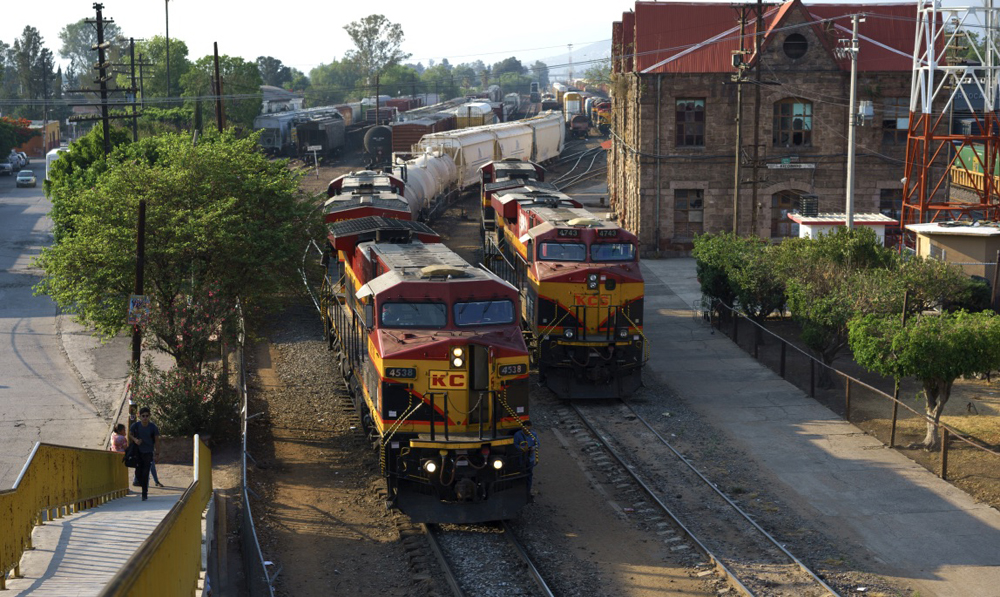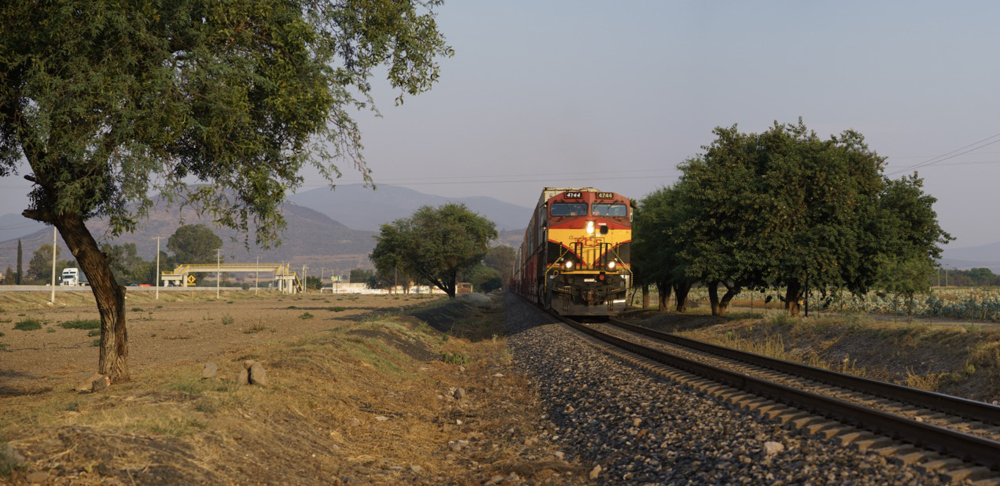
KANSAS CITY — Kansas City Southern de Mexico is battling congestion in key terminals thanks to a combination of stronger than expected traffic growth and a shortage of train crews.
The congestion, which began in December, now threatens to gum up Kansas City Southern’s U.S. network less than four weeks before Canadian Pacific gains control of the railroad and creates Canadian Pacific Kansas City.
But KCS says the railroad is on the mend. “KCSM’s service metrics are steadily improving and are expected to be at normal fluidity within two to three weeks,” KCS spokeswoman Doniele Carlson says.
Rick Paterson, a Loop Capital Markets analyst who closely tracks railroad performance measures, says the most recent KCS data shows a decline in velocity for the week ending March 18. Although systemwide dwell was down, it was up at Laredo, Texas.
“It’s pretty indisputable at this point that KCS de Mexico has melted down, with all the headaches that entails: unhappy customers, defections to truck, strained relations with all stakeholders, including government, and the typical one-year timeframe for a full service recovery,” Paterson wrote in a note to clients on Friday. “This is what Canadian Pacific is going to face on April 14 when the deal closes and the two systems are legally combined. We’re sure CP has thousands of pages of integration plans for KCS, but restoring and stabilizing service at KCSM has no doubt jumped to the top of page one.”
Traffic on KCS de Mexico is up 8.8% so far this year, compared with a 2% decline in KCS volume in the U.S. Systemwide, train velocity is down 22% compared to a year ago, while terminal dwell is up 35% through March 10, Paterson notes.
The congestion in Mexico is affecting most major KCSM terminals, including Monterrey, San Luis Potosi, and those in the Mexico City area. Terminal dwell is high at both of KCS de Mexico’s border yards in Nuevo Laredo, Mexico, where cars are spending an average of nearly 45 hours.
Dwell at Laredo, Texas, is 25 hours, a two-year high. Terminal dwell has risen for four straight weeks at the KCS hub of Shreveport, La., where cars spent 45 hours, on average. Paterson says that’s the highest in data going back to March 2017.
KCS de Mexico has taken numerous steps to ease the congestion. Among them:
- It has hired crews and has been negotiating with unions for more flexible work rules.
- Added 50 locomotives to the active fleet since Jan. 1.
- Sent high-ranking management to various trouble spots.
- Worked more closely with Ferrovalle to reduce congestion at interchanges.
- Updated train schedules to ensure that Monterrey has the capacity to move traffic south more frequently.
- Established a “war room” with teams from different departments.
“We continue to work aggressively to resolve the situation and are optimistic that improvements will be notable in the coming weeks,” KCS said in its latest service advisory, which was issued on Feb. 27.
CPKC is retaining key KCS operating executives. CPKC’s management team will include KCS’s current chief operating officer, the president of KCSM, and current CEO Pat Ottensmeyer will serve as an advisor through the end of the year. Meanwhile, Mark Redd, executive vice president of operations at CP, was once vice president of transportation at KCS. He will become CPKC’s operations chief.















“Traffic on KCS de Mexico is up 8.8% so far this year ” That is a significant increase, and given any even modest crew shortages, is enough to tip the system into unpleasant territory, as shown by the increases in terminal dwell.
KCSM yards at Monterrey and San Luis Potosi are surrounded by their cities, with little available room for expansion. SLP has had some plant improvements, and a MTY bypass that can be used by FXE will certainly help. But these changes won’t be in place tomorrow.
In the meantime, the steps being taken are those that would be taken by any railroad.
CP+KCS being an end-to-end combination, there aren’t alternate routes available that could enable some manner of bypass or run-thru operation that could bypass SLP or MTY. Sanchez [Nuevo Laredo] is a new yard built on a greenfield site, but it is a flat yard, not a hump, and so has limited capacity.
But it may be that the growth in traffic might enable SLP-built trains to bypass MTY and operate through to KCS or UP. MTY already builds such trains, and UP does likewise southward, to avoid switching at the border.
Here we go again, same old €¥√| again.
Lets prey not. KCS has had good management. Keith Creel knows what he doing.
I hope I don’t have to eat these words!
Hiring crews will have little effect until a year passes. The bridge was always a parking lot, even back in MP days. But, the SP-UP merger in Houston was far, far worse. Trains as far away at 250 miles plus, sat in sidings for days, some weeks.
When you add the fact Mexico railroads were never as plentiful or modern as in the US, it doesn’t take much to delay shipments. Add the fact KCS’ money bag was not near as full of cash as was UP’s making it much longer to bring capacity up to date. As much as I hate to see KCS go maybe CP can afford to get things right.
How much of the 25 hour delays at Laredo are due to the bottleneck at the bridge over the Rio Grande? A place where a brand new bridge is being built as we type that will double cross border capacity?
The operational problems on the Mexico side may be caused by the delays in getting traffic across the bridge in a reasonable amount of time. An issue that has existed for sometime, hence the new bridge.
I hope everyone will notice that competing railroads with be doing this day to day press release bombardment on “what is wrong with CPKC today”.
A month or so ago it was UP and Foster Farms. The past few weeks it has been NS and East Palestine. Now look for the “see what the merger did” noise.
“Failure to plan is planning to fail”
Having worked through the carve-up of Conrail in 1999, and seeing how the NS had attempted to integrate its part of Conrail into the NS network on Day 1, and what an awful mess they made of it, all I can say is watch out. Sounds like the UP-SP merger a few years earlier was just as bad in some places. How many carloads and how much revenue was lost – and never came back – we will never know. Let’s hope this CP-KCS merger does not go that way.
It’ll be worth watching for sure!
Given that many mergers in the past did have this kind of congestion occur at some point, I’m kinda not surprised that something like this is occurring. But hopefully, KCS manages to fix these issues, and if CP is having any issues like this on their part, hopefully they can fix that as well.